Warning! Big flavors are in your future with fresh veggies, jackfruit, and pineapple swimming in a luscious easy-to-make Thai-inspired green curry sauce.
Jackfruit curry bowls are a nutritious, plant-based way to satisfy your craving for big bowls of saucy, slurp-worthy noodles.
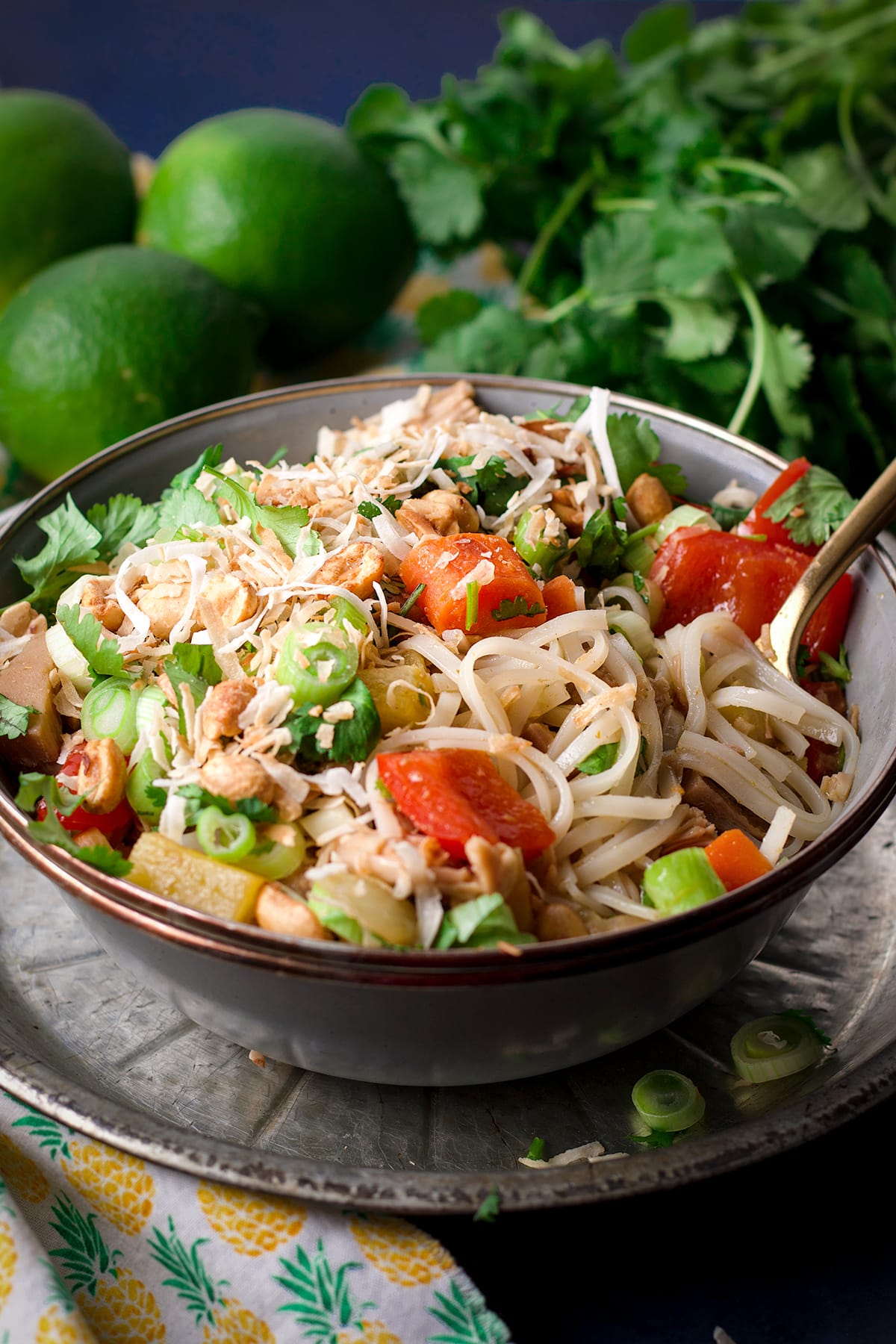
These curry bowls are packed with sautéed veggies, tender jackfruit, and juicy chunks of pineapple. They have that savory-sweet-and-sour thing going on that I absolutely, positively adore. Think roasted cauliflower soup topped with crispy fried mushrooms, cauliflower and chickpea curry with coconut, or Thai curry shrimp and rice. YUM and yes, please to all of that and more.
The green curry sauce is super easy to make and honestly, you are more than welcome to make it a red curry sauce if that's your preference. Because these noodle bowls are one of those things made to be customized to whatever you want.
Use different noodles, different veggies, oranges or mangos instead of pineapple, and red curry instead of green. It's all so very good and nourishing in the most delicious and satisfying way.

+ Subscribe to my newsletter for new and exclusive recipes in your in-box every month! As a full time traveler, living, working, cooking, and baking from a 5th wheel RV, it's also where I share our experiences of life on the road.
What is Jackfruit?
Jackfruit is a huge tropical fruit with a prickly exterior. It’s a remarkably versatile fruit that can be used in both sweet and savory dishes. In Thailand and other Southeast Asian countries, jackfruit is often used in curries.
But the incredible flavor and versatility of this fruit is catching on and it’s becoming easier to find in grocery stores, markets, and on restaurant menus worldwide.
Jackfruit is an especially popular ingredient in vegan cooking because it is an excellent substitute for meat! For example, these vegan stuffed sweet potatoes are packed with buffalo-sauced jackfruit instead of meat. Replacing the traditional lamb in gyros with jackfruit gives you all the flavor and texture without any actual meat. Use jackfruit in place of pork for pulled pork sandwiches or in soups and stews like this jackfruit chili and vegan taco soup.
I used canned jackfruit in this recipe, but if you can get your hands on a fresh jackfruit it's worth the effort of preparing it for cooking and eating! Fresh jackfruit are HUGE and can be intimidating. But, my friend Helene has written a fantastic tutorial about how to cut jackfruit that will walk you through the process. You'll find the process easy and fresh jackfruit is fantastic!
Ingredients Needed to Prepare this Recipe
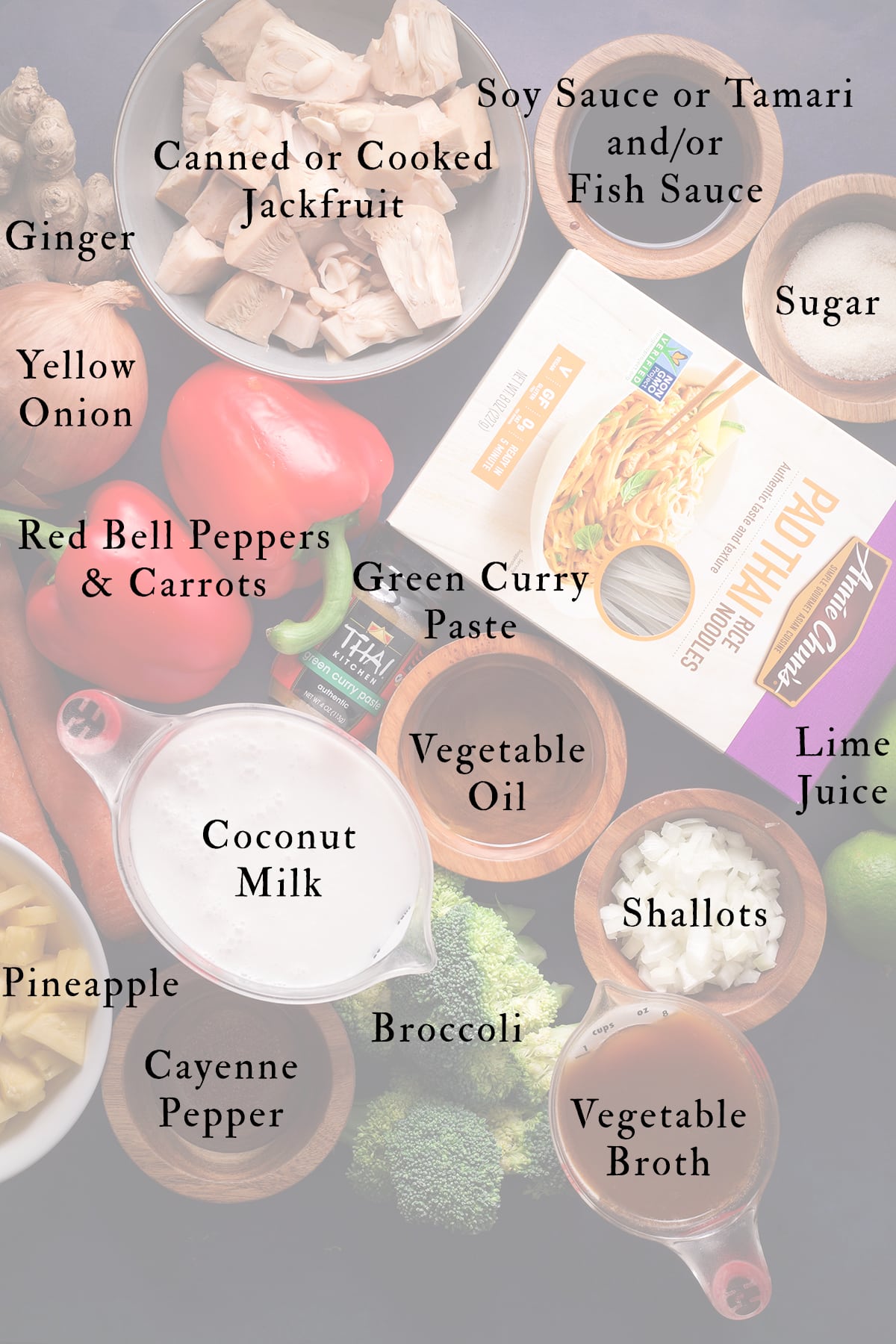
- Vegetable or canola oil
- Chopped shallots
- Fresh ginger
- Green curry paste. I used Thai Kitchens Green Curry Paste. But, you can use red curry paste if you prefer or curry powder.
- Coconut milk, unsweetened, from a carton or a can. Any kind is fine, except any kind labeled "light". I used Thai Kitchen Coconut Milk.
- Vegetable broth. I used Better Than Bouillon Vegetable Base mixed with water. I always have this and several other Better Than Bouillon jars in my refrigerator. The flavor is fantastic and keeps in the refrigerator for months, making it much more convenient than cans or cartons of stock. (The Adobo Base is particularly fantastic in simple homemade Mexican Adobo Sauce.)
- Sugar. Just a bit of sugar in the curry sauce brightens and adds balance to the overall flavor of the dish.
- Cayenne. A bit of ground cayenne (or more!) is optional for those of you who want to add a bit of heat to your curry sauce.
- Fish sauce and/or soy sauce or tamari. This recipe includes the option to use a combination of fish sauce and soy sauce OR only soy sauce. Obviously, if you want to keep this curry vegan, omit the fish sauce. Or use a vegan fish sauce. And, if you want to make your curry gluten-free or soy-free, use Tamari instead of soy sauce.
- Canned Jackfruit. Or cooked fresh, unripe jackfruit. I used Native Forest Organic Young Jackfruit.
- A yellow onion.
- Carrots, broccoli, and red bell peppers. OR, use any combination of vegetables you like. See the substitutions and additions section below for suggestions.
- Pineapple chunks. Use fresh pineapple in this recipe or canned pineapple. If using canned, choose pineapple packed in pineapple juice rather than syrup to avoid making the curry too sweet.
- A few fresh limes. 1-3 tablespoons of fresh lime juice is essential to adding enough acid to the curry to balance and brighten all the other flavors. But I also like to serve these jackfruit curry bowls with a few slices of fresh lime so everyone can add a bit more lime juice to their portion if they like.
- Pad Thai Rice Noodles. I used Annie Chun's Pad Thai Rice Noodles.
- Suggested toppings: roasted or raw cashews or peanuts, diced green onions, chopped fresh cilantro, and toasted sweetened or plain shredded coconut
If you are using fresh pineapple you'll likely have quite a bit leftover. Use the leftover pineapple to make tall refreshing glasses of pineapple water, the perfect drink to serve with these curry bowls!
*See the recipe card below for precise quantities.
Substitutions and Additions
- Instead of carrots, broccoli, and red bell peppers, use any combination of vegetables you like in this curry. Or, stick with carrots, broccoli, and red bell peppers but also toss in a few more vegetable varieties. This really is one of those recipes for which you can use pretty much any kind or combination of vegetables you like. A few ideas include cauliflower, zucchini, green beans, snow peas, yellow squash, and yellow, orange or green bell peppers.
- For vegan jackfruit curry bowls be sure to omit the fish sauce or use vegan fish sauce.
- For gluten-free jackfruit curry bowls be sure to use rice noodles that say on the package that they are gluten-free and Tamari instead of soy sauce.
- Use red curry paste or curry powder instead of green curry paste. I prefer to make the curry sauce with green curry paste, but red curry paste is also delicious. I've also included instructions in the recipe card to substitute curry powder for curry paste.
- Instead of pineapple use oranges or chunks of fresh mango. You can also omit the pineapple if you aren't crazy about fruit in savory dishes like curry.
- Not a fan of ginger? Neither is my husband. 🙂 Luckily, you can add a bit of ground allspice, cinnamon, mace, or nutmeg instead of fresh ginger if you like, or a combination of any or all of those spices. Or, leave the ginger out entirely. This curry has plenty of flavor without it.
- Allergic to alliums? If you or someone you're cooking for can't eat onions or scallions, you can simply leave them out of this recipe or replace them with some chopped fennel.
- Instead of rice noodles, use Chinese egg noodles, vermicelli noodles, glass noodles, udon noodles, soba noodles, or even spaghetti noodles. Remember that if you're cooking for someone who is on a gluten-free diet to choose noodles that do not contain gluten.
Step-by-Step Photos and Instructions
I like to cook the pad Thai rice noodles before starting on the curry so they are ready when I am. Cook the noodles according to the package directions, then drain them in a colander in the sink and immediately rinse with cold water to stop them from cooking. Set the noodles aside while you make the curry.
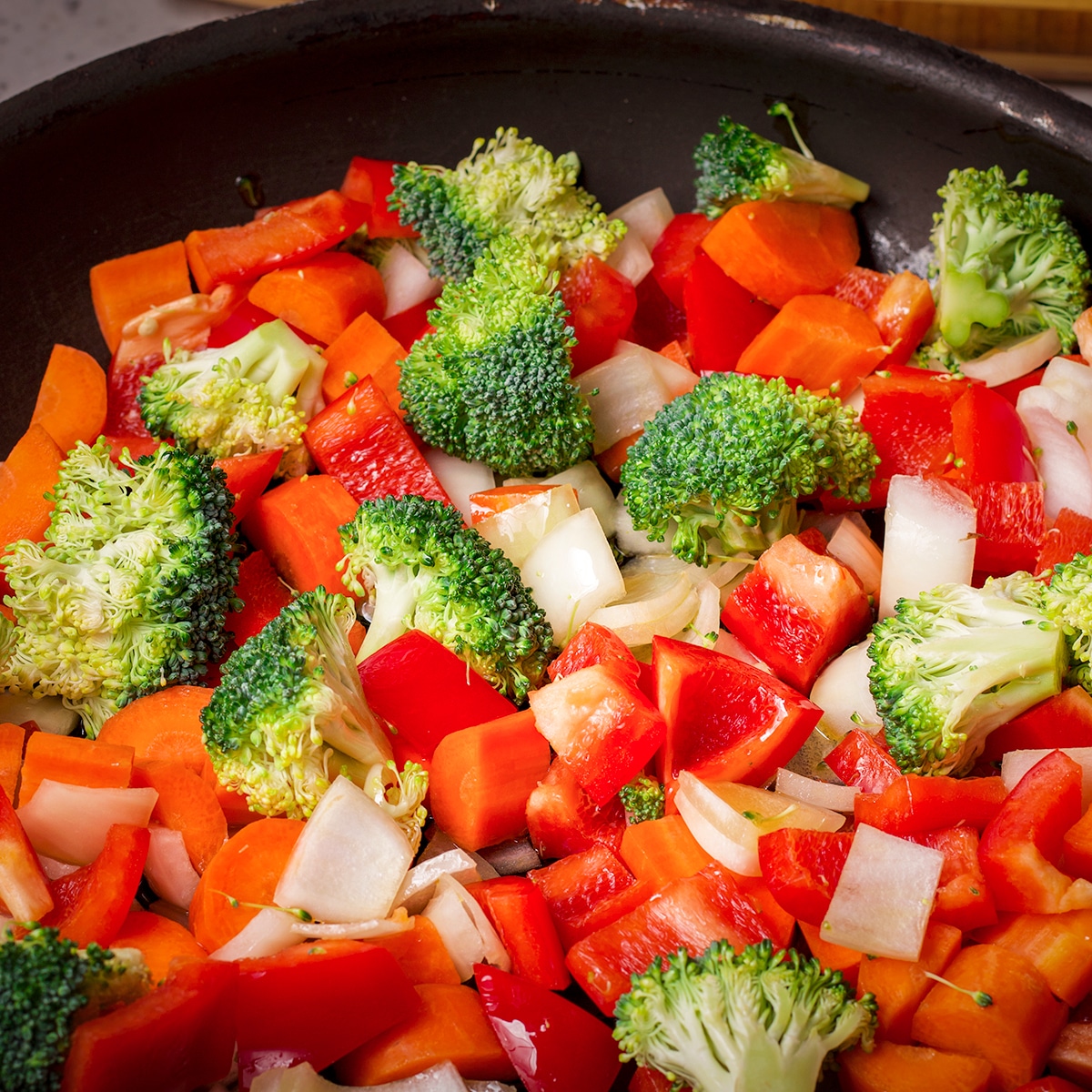
Before you begin making this curry, chop the vegetables. Chop the shallot into small pieces and the rest of the vegetables into bite-size pieces. The size of the pieces doesn't really matter; what's important is that they are all relatively the same size so they cook at the same rate.
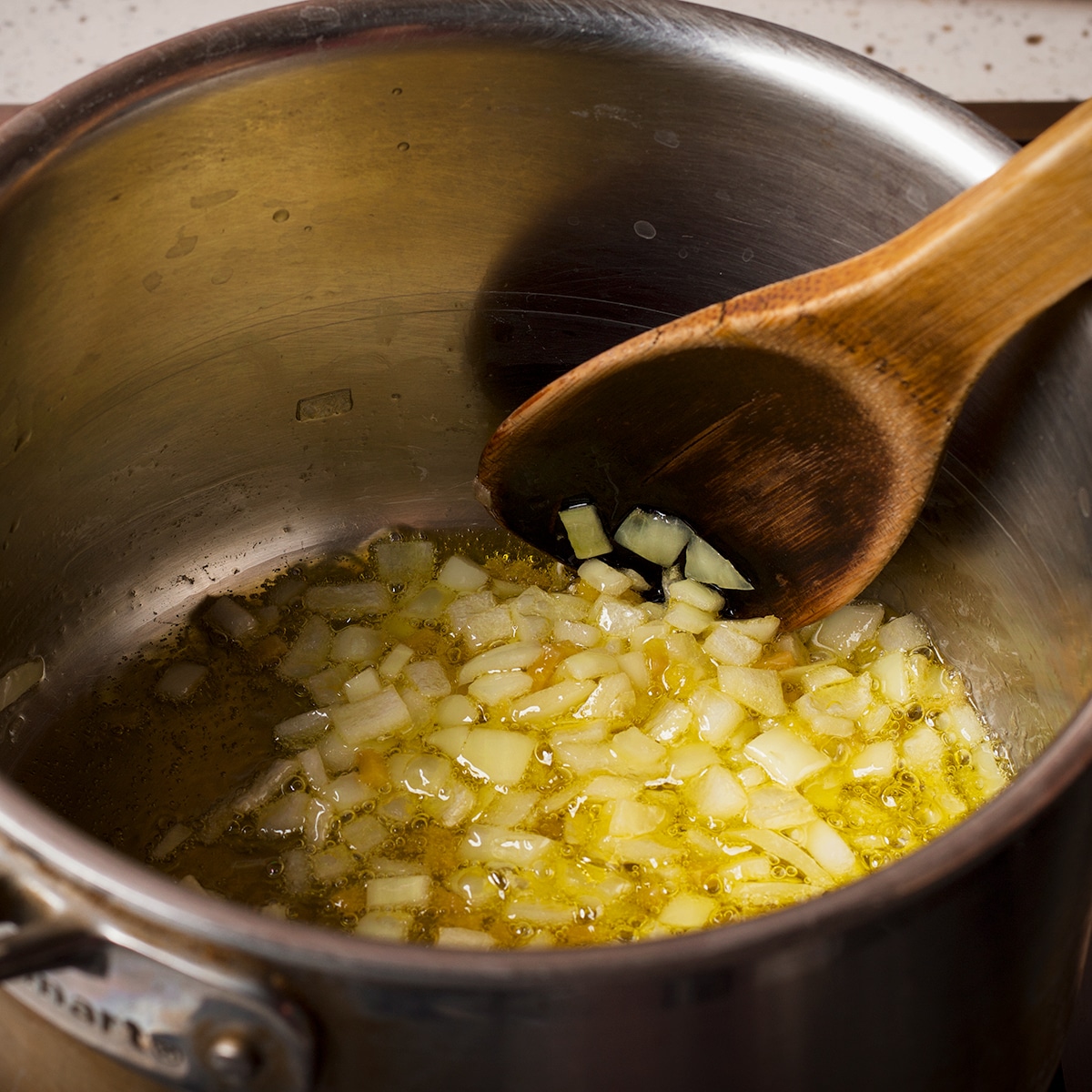
Add some oil, chopped shallots, and minced or grated ginger to a saucepan and cook over medium heat for a couple of minutes until the shallots are soft.
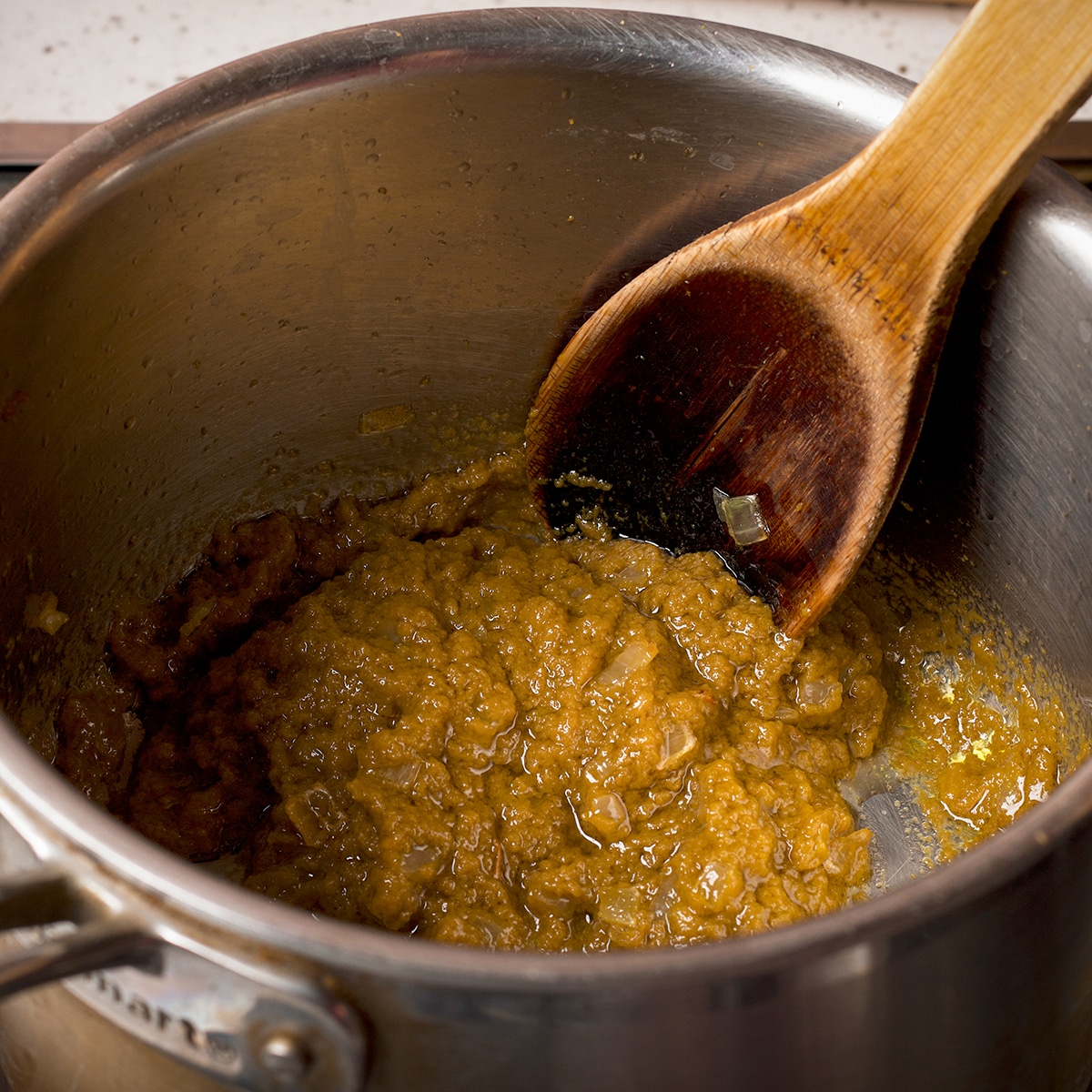
Add the curry paste or curry powder and cook, stirring constantly, for 1 minute.
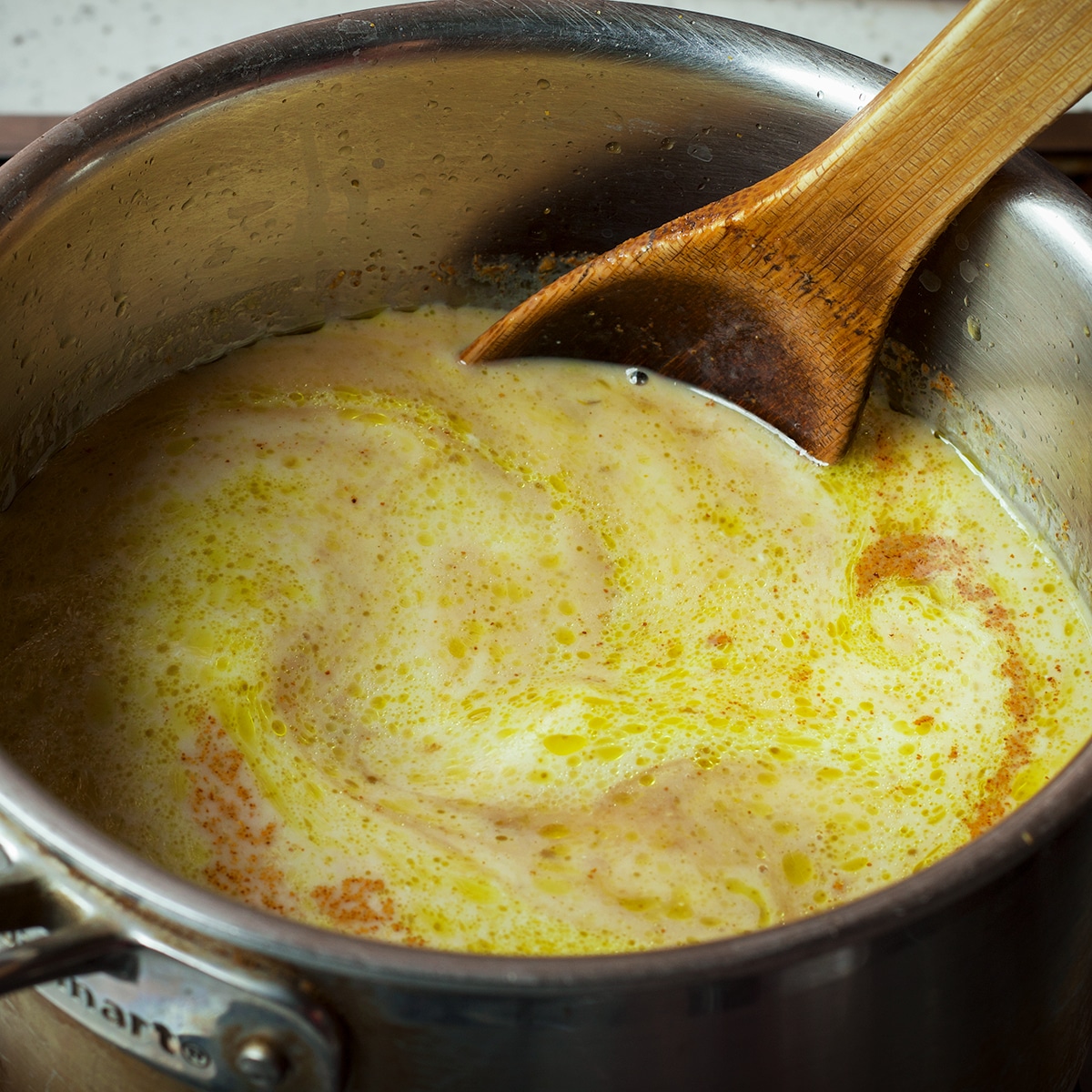
Stir in the coconut milk, vegetable broth, sugar, cayenne (if using), fish sauce (if using), and soy sauce or Tamari.
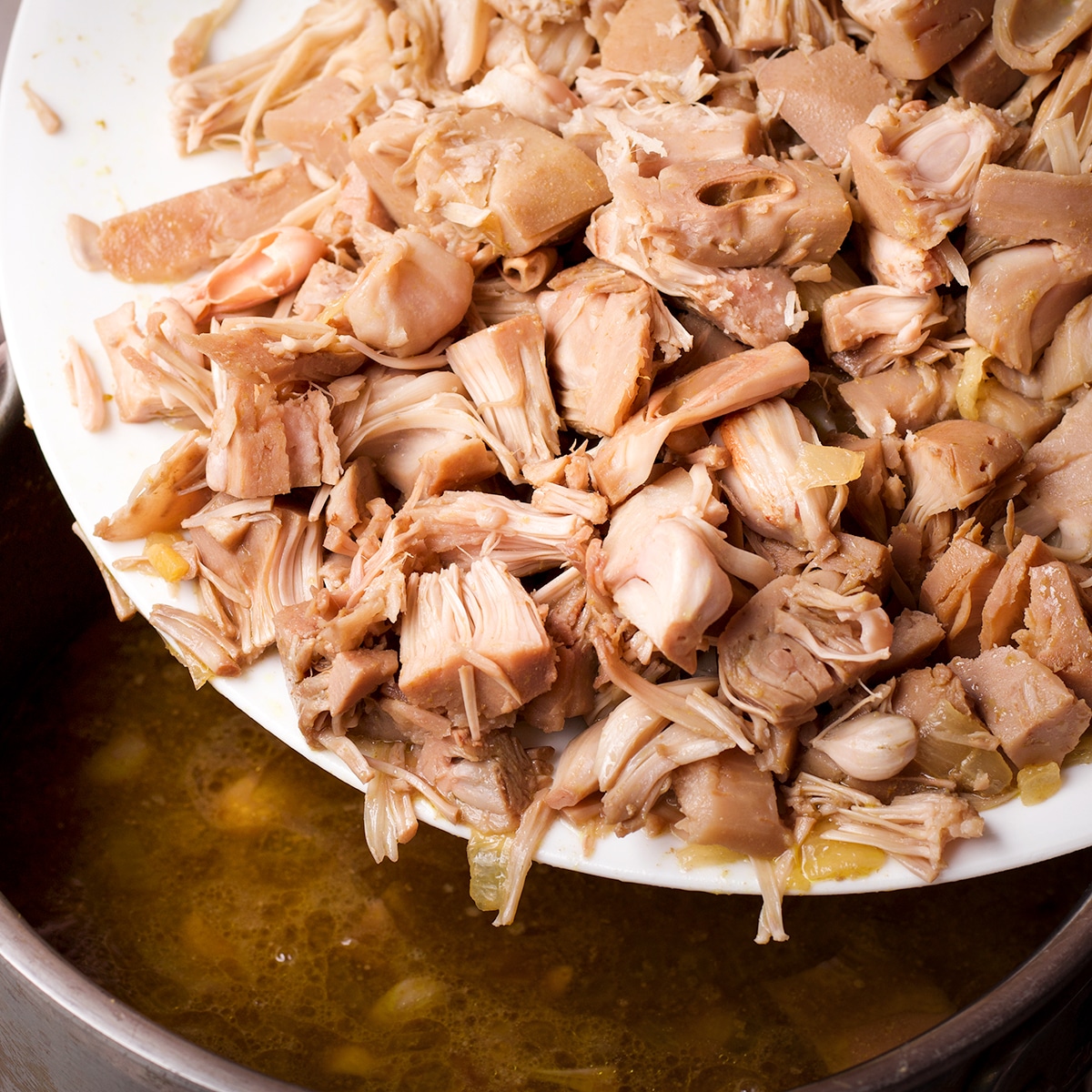
If the jackfruit is in large chunks, use your fingers or two forks to shred it into bite-size pieces. Add the Jackfruit to the curry sauce.
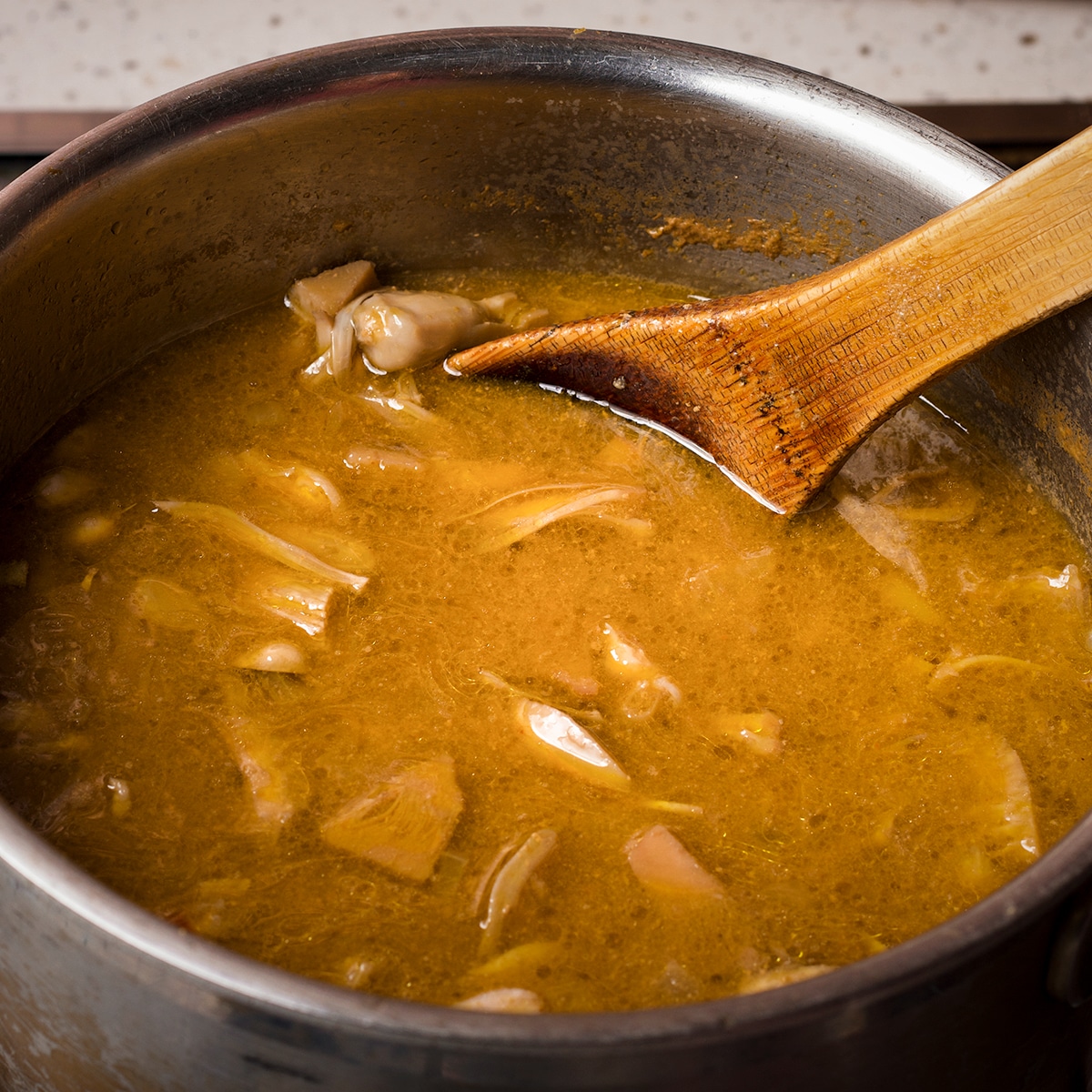
Let the jackfruit simmer in the curry sauce for 20 minutes while you cook the veggies.
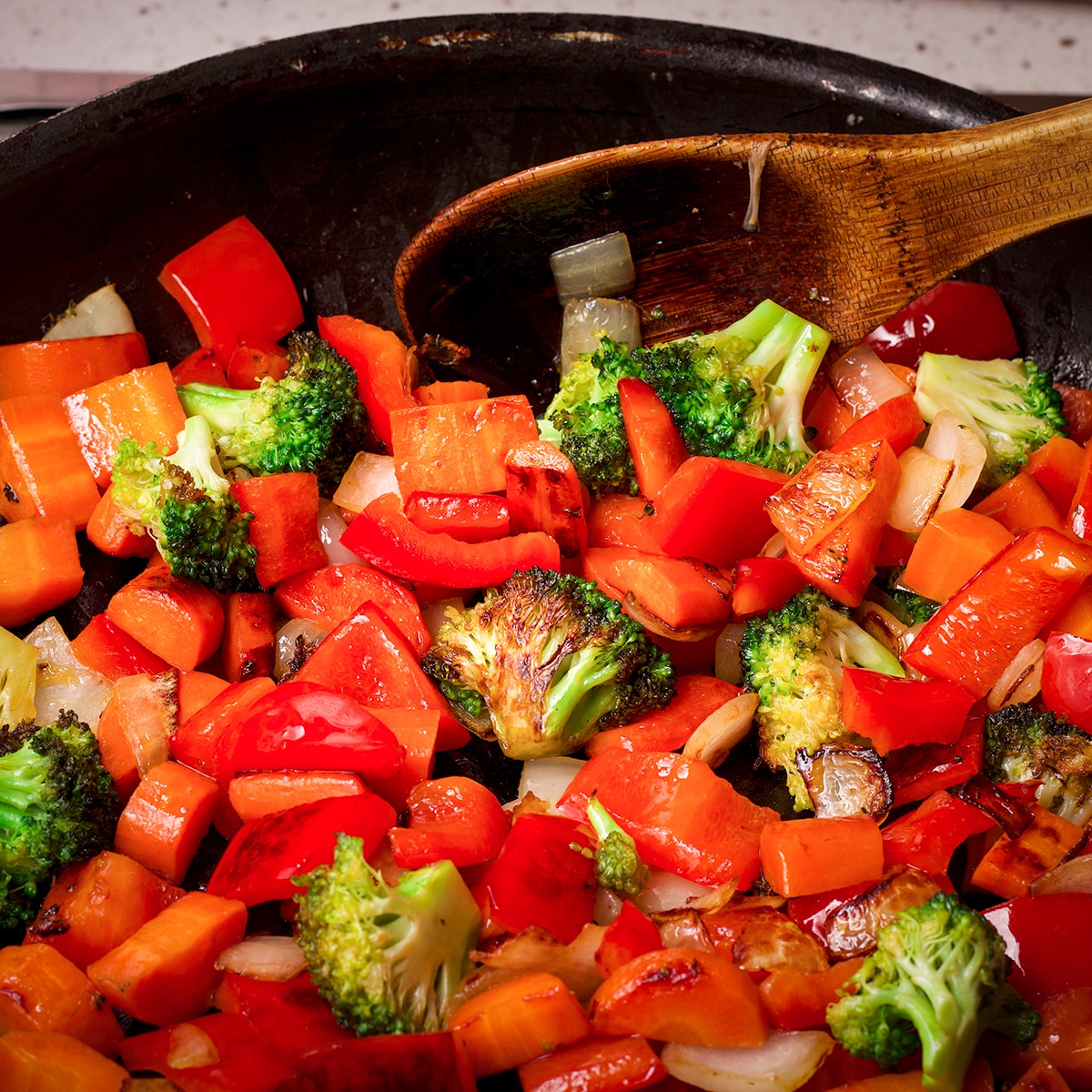
Cook the chopped vegetables in a bit of oil in a skillet set over high heat. Sauté until the veggies are starting to brown in spots.
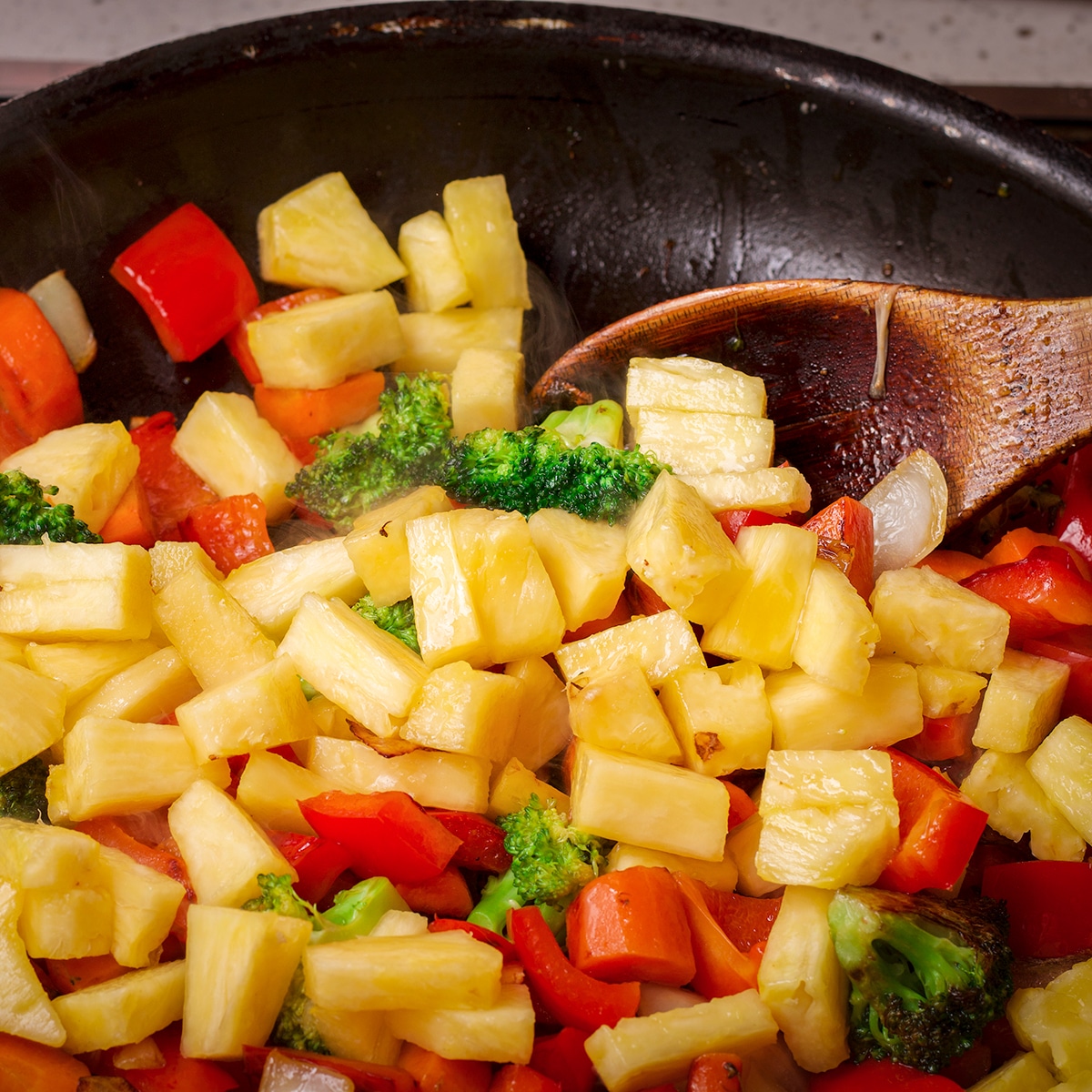
Stir the pineapple into the veggies.
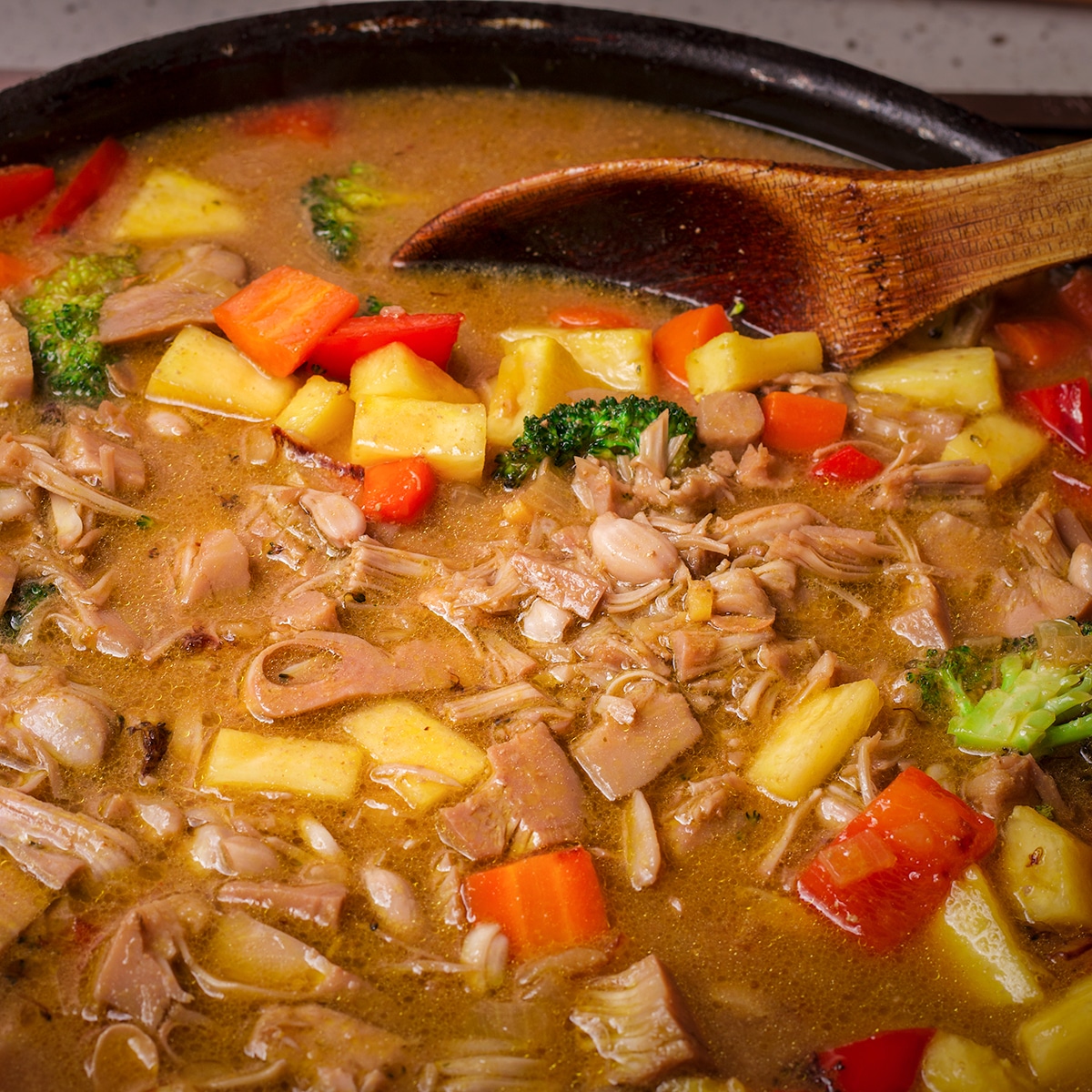
Then add the jackfruit and curry sauce.
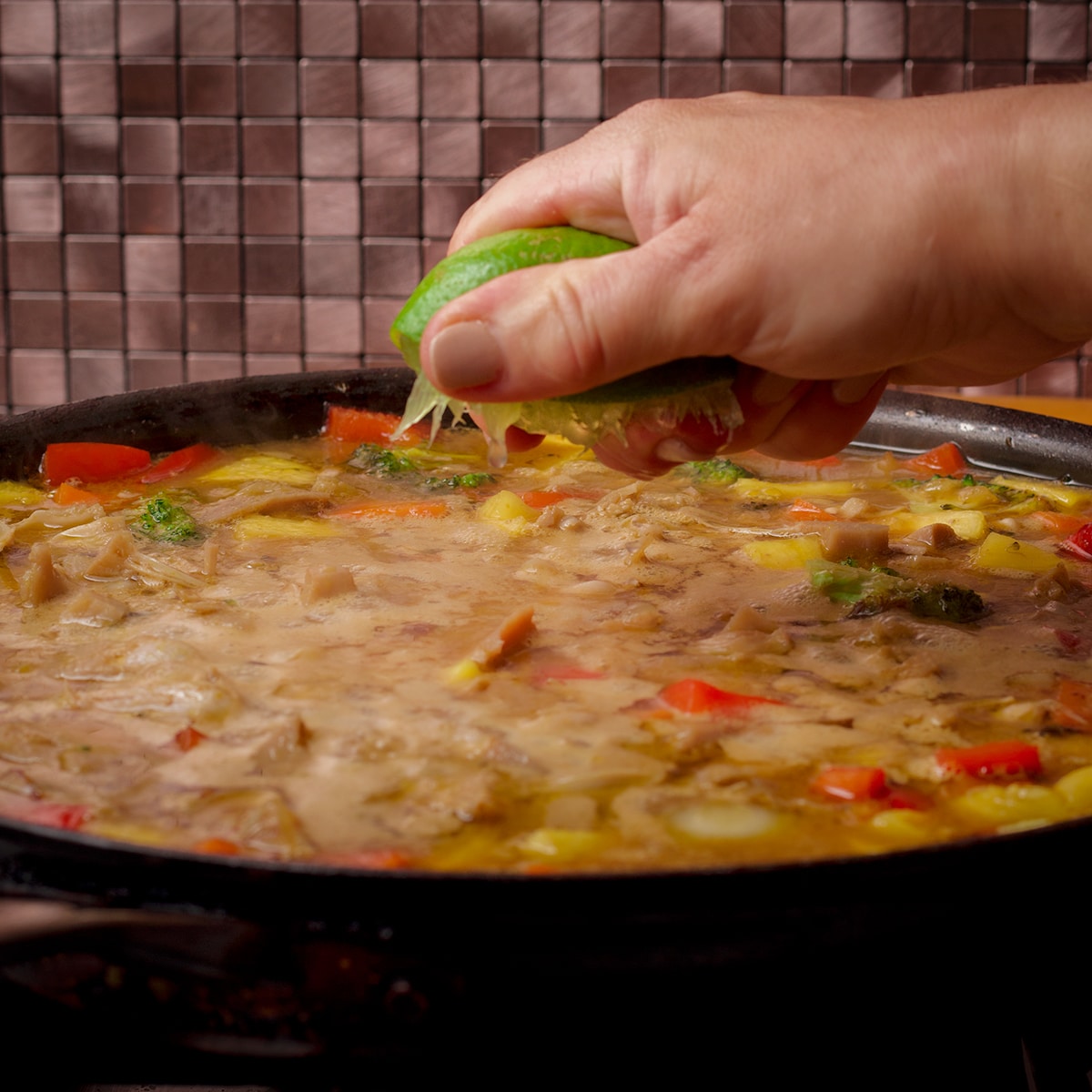
Squeeze some lime juice into the curry, taste, and add more lime juice and salt if you like.
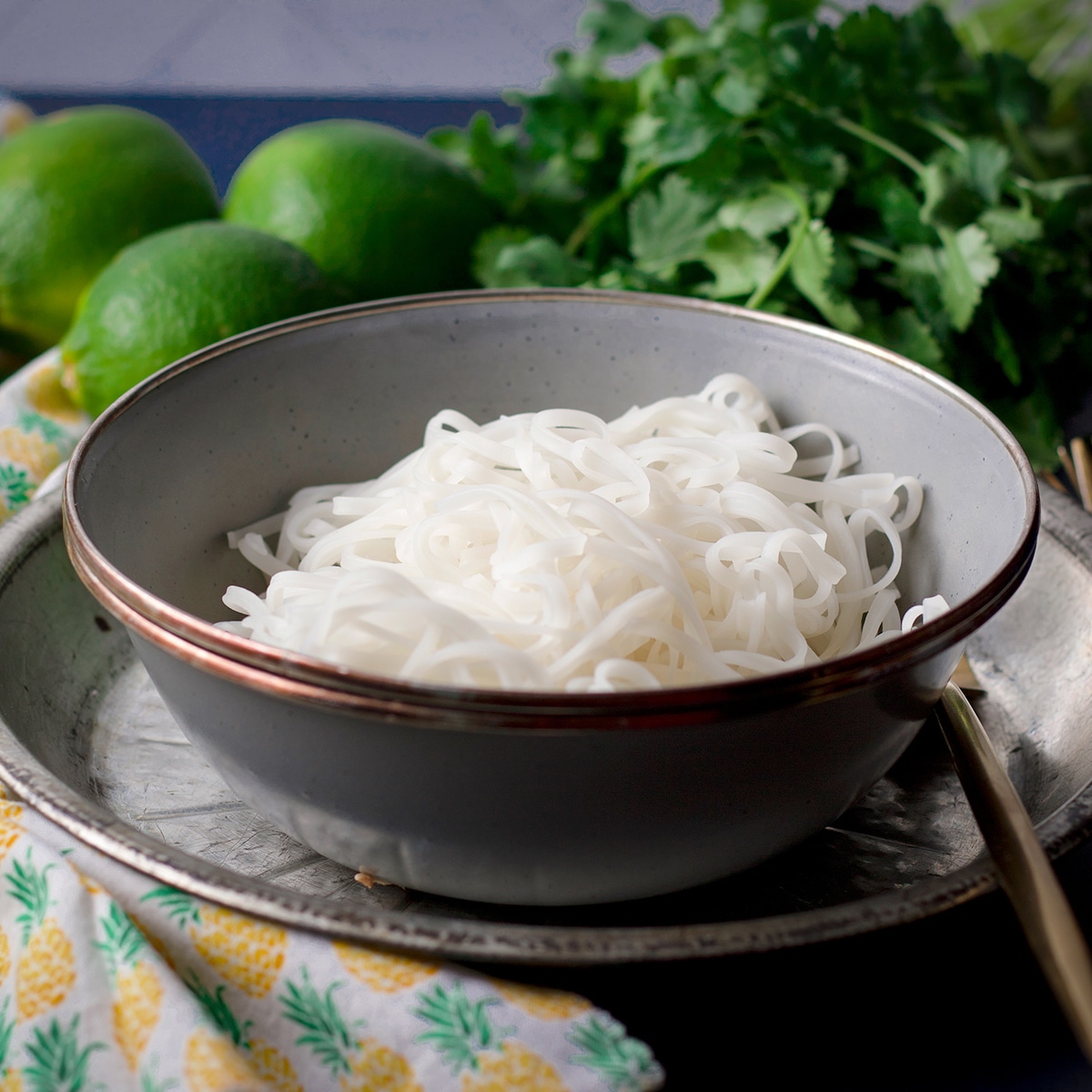
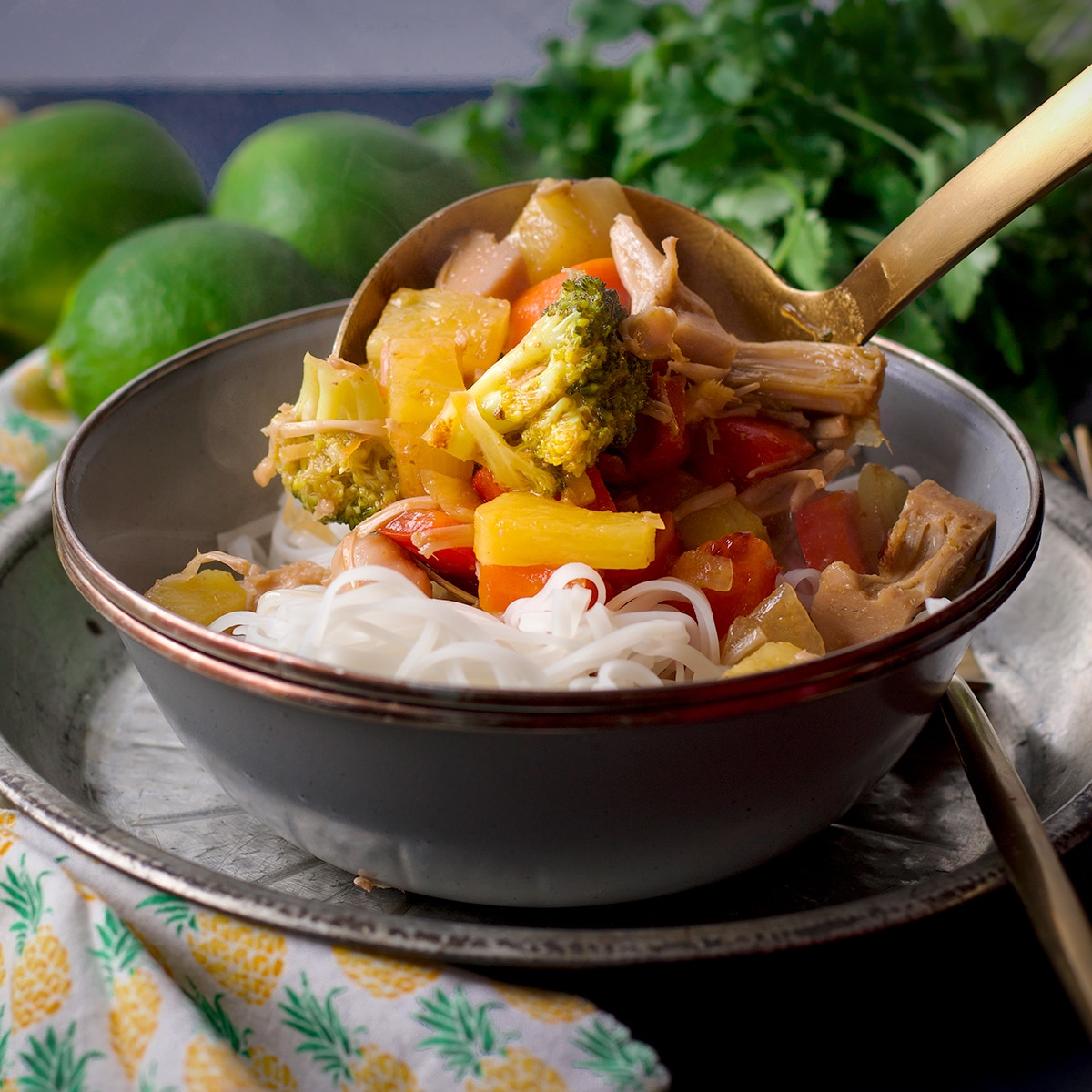
To serve, pile some rice noodles into bowls and ladle hot jackfruit curry over the noodles. The curry will warm the noodles.
Serve with any or all of the suggested toppings: roasted or raw cashews or peanuts, diced green onions, chopped fresh cilantro, and toasted sweetened or plain shredded coconut
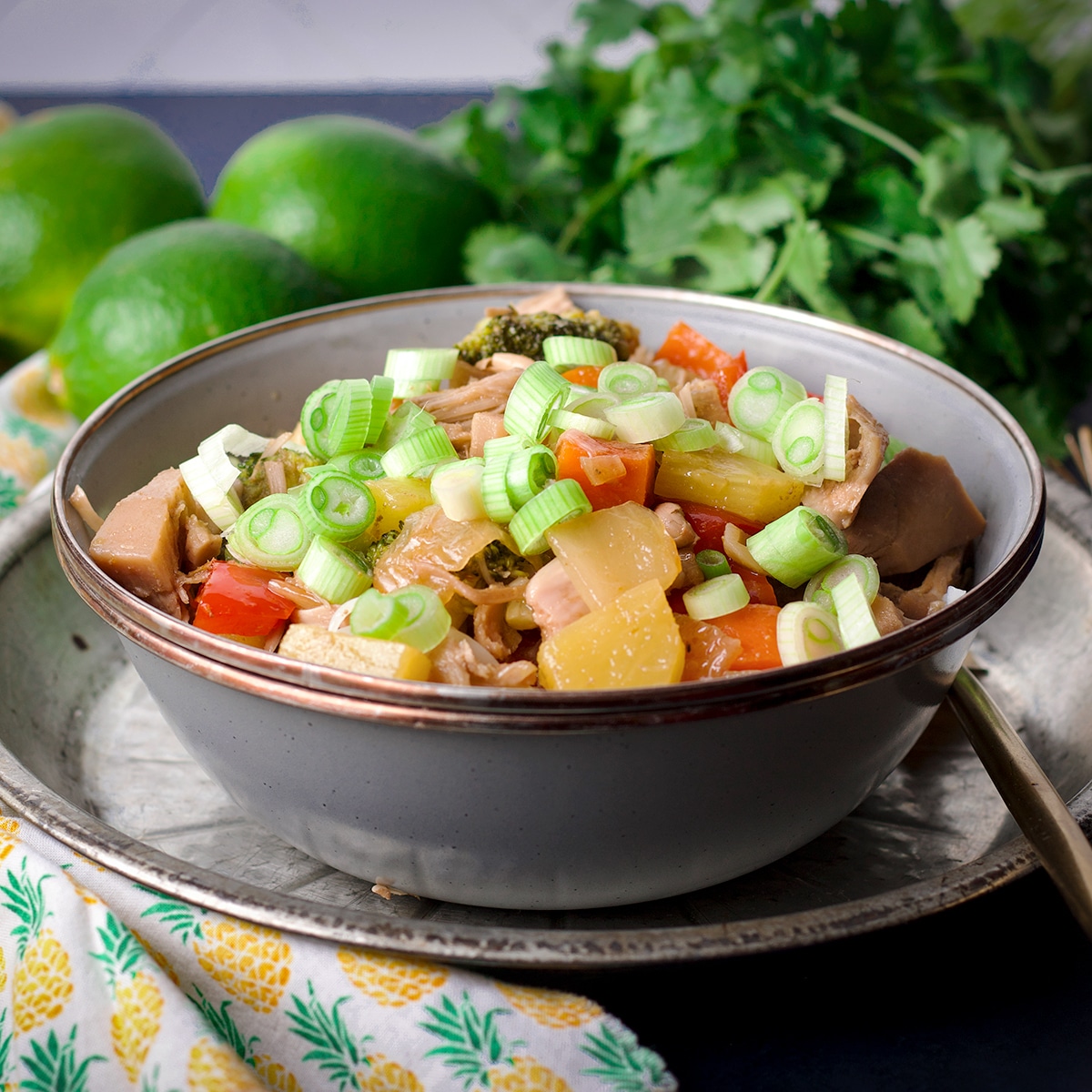
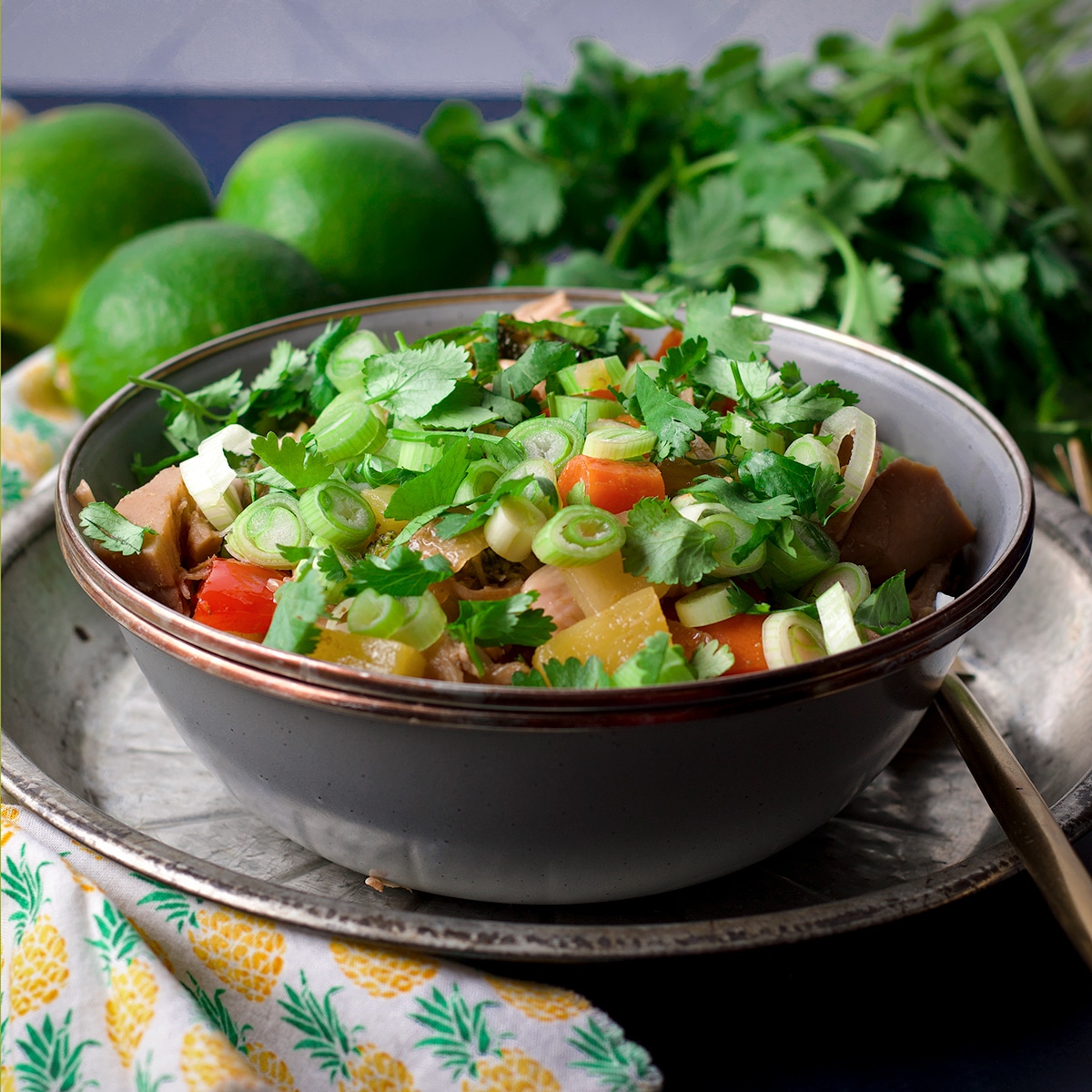
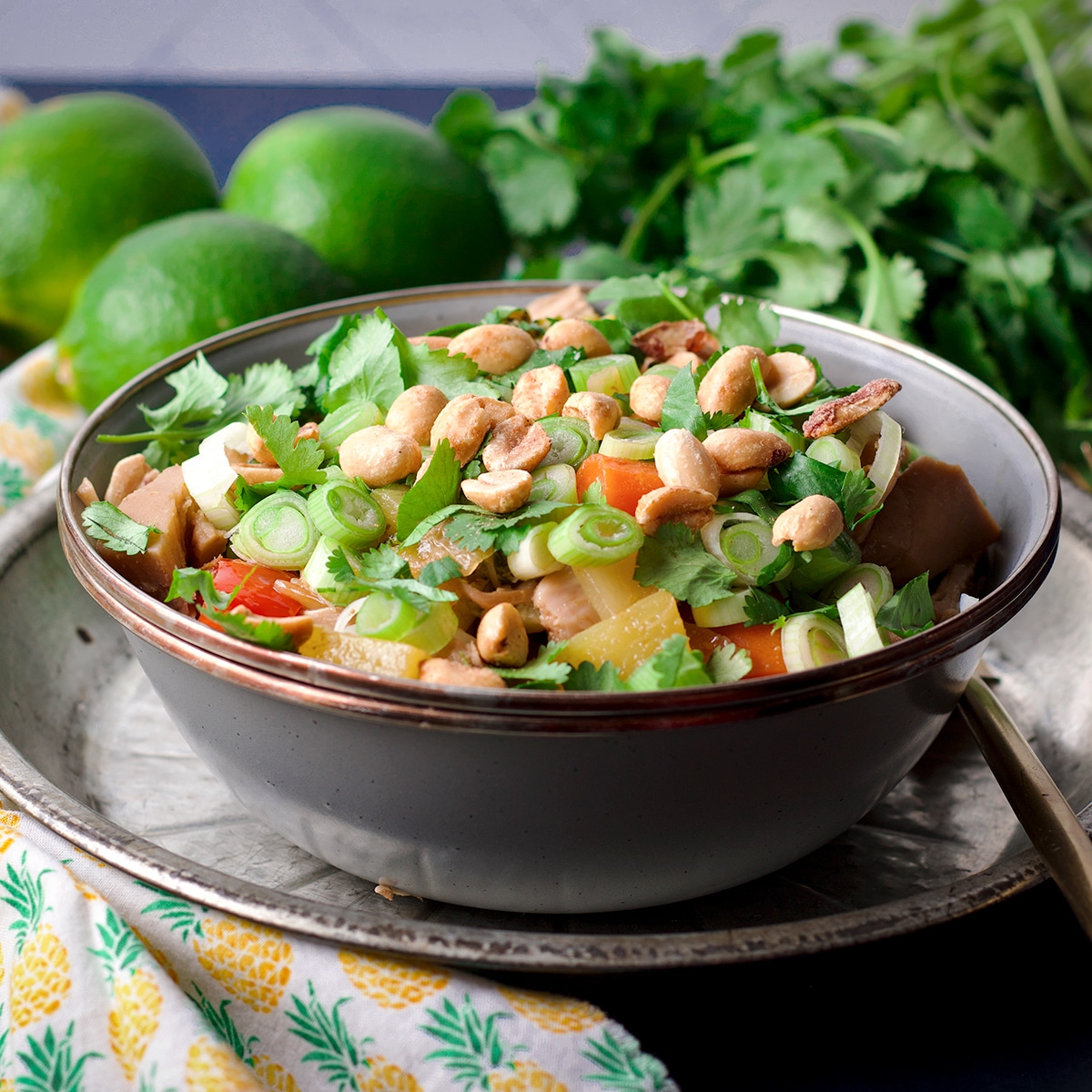
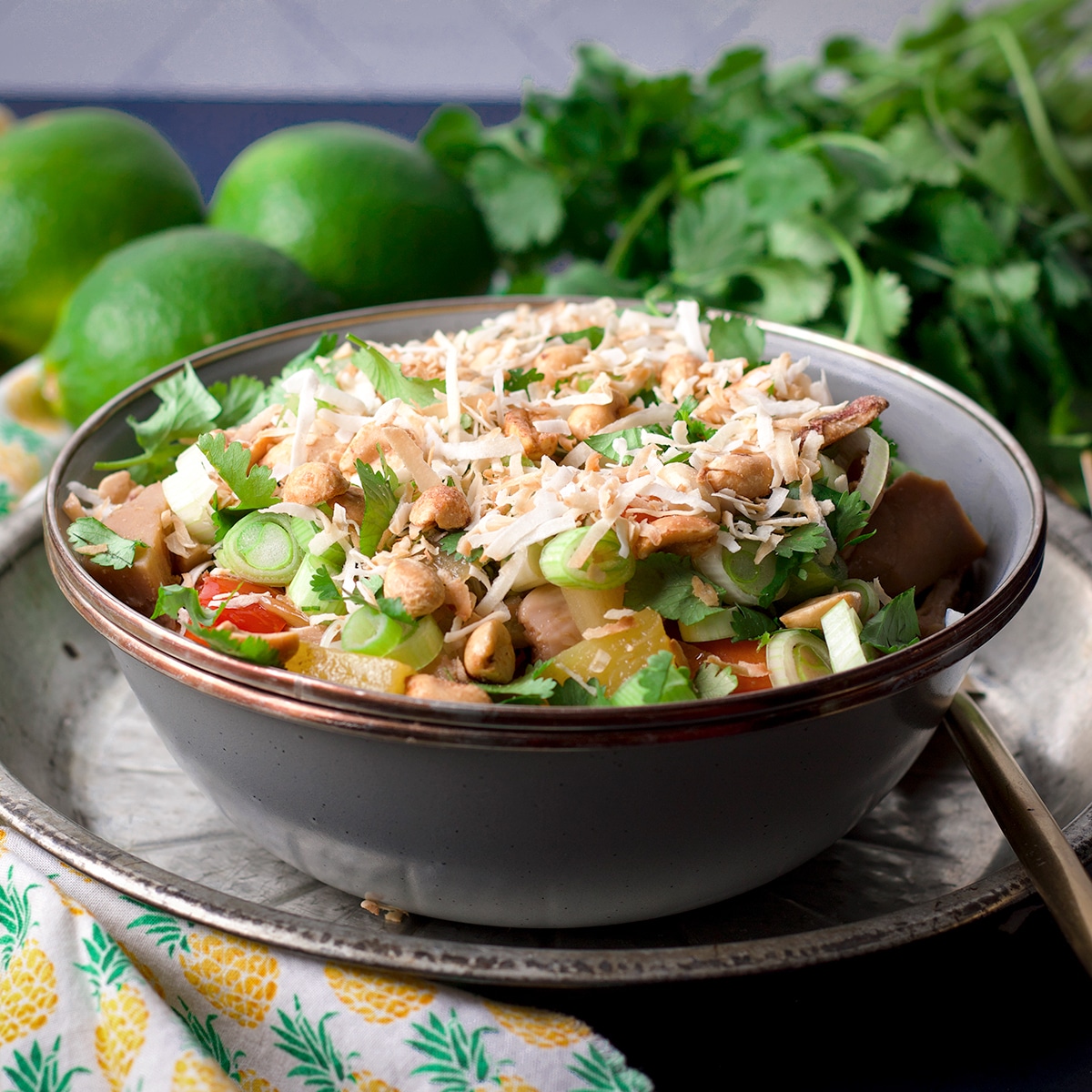
How to toast coconut: Add some shredded coconut, sweetened or unsweetened, to a dry skillet and set it over medium heat. Cook, stirring constantly, until about 50% of the coconut is golden. If you cook it much longer than that some of the coconut shreds will begin to burn. Scrape the toasted coconut onto a plate and allow it to cool.
Useful Equipment for Making Curry
There are really only three pieces of equipment needed to make jackfruit curry bowls: A large skillet, a medium size saucepan, and a large saucepan. Here are the pans I have in my kitchen:
- A Cuisinart 8-quart Stockpot. This size is ideal for cooking the pad Thai noodles.
- Cuisinart 2-Quart Saucepan or 3-Quart Saucepan. I have limited space in my tiny kitchen so I only keep three saucepans: an 8-quart, 3-quart, and 1-quart. But in this recipe, a 2 or 3-quart saucepan will work equally well for cooking the curry sauce.
- A 12-inch skillet or larger. As you can see from the photos above, this recipe will fill a 12-inch skillet to the brim.
It's also helpful to have a sharp knife. I've owned this set of Mercer Culinary Knives for years and continue to be happy with them.
Make Ahead and Storage Instructions
Cooked rice noodles can be stored in the refrigerator for up to 5 days. Toss them with a drizzle of vegetable or canola oil to keep them from clumping together.
Cooked jackfruit curry can be stored in a covered container in the refrigerator for up to 5 days. Reheat in the microwave or over medium-low heat in a saucepan on the stovetop.
I recommend storing the noodles and curry separately. Tossing the noodles with the curry before storing can cause the noodles to get a bit soggy. There's no need to heat the noodles before serving. Just heat up the curry and pour the hot curry over the noodles to heat them up.
Cooked jackfruit curry can be frozen for up to 3 months, but the veggies tend to get a bit soggy. The texture of this dish is best eaten fresh or reheated after storing in the refrigerator for a few days.
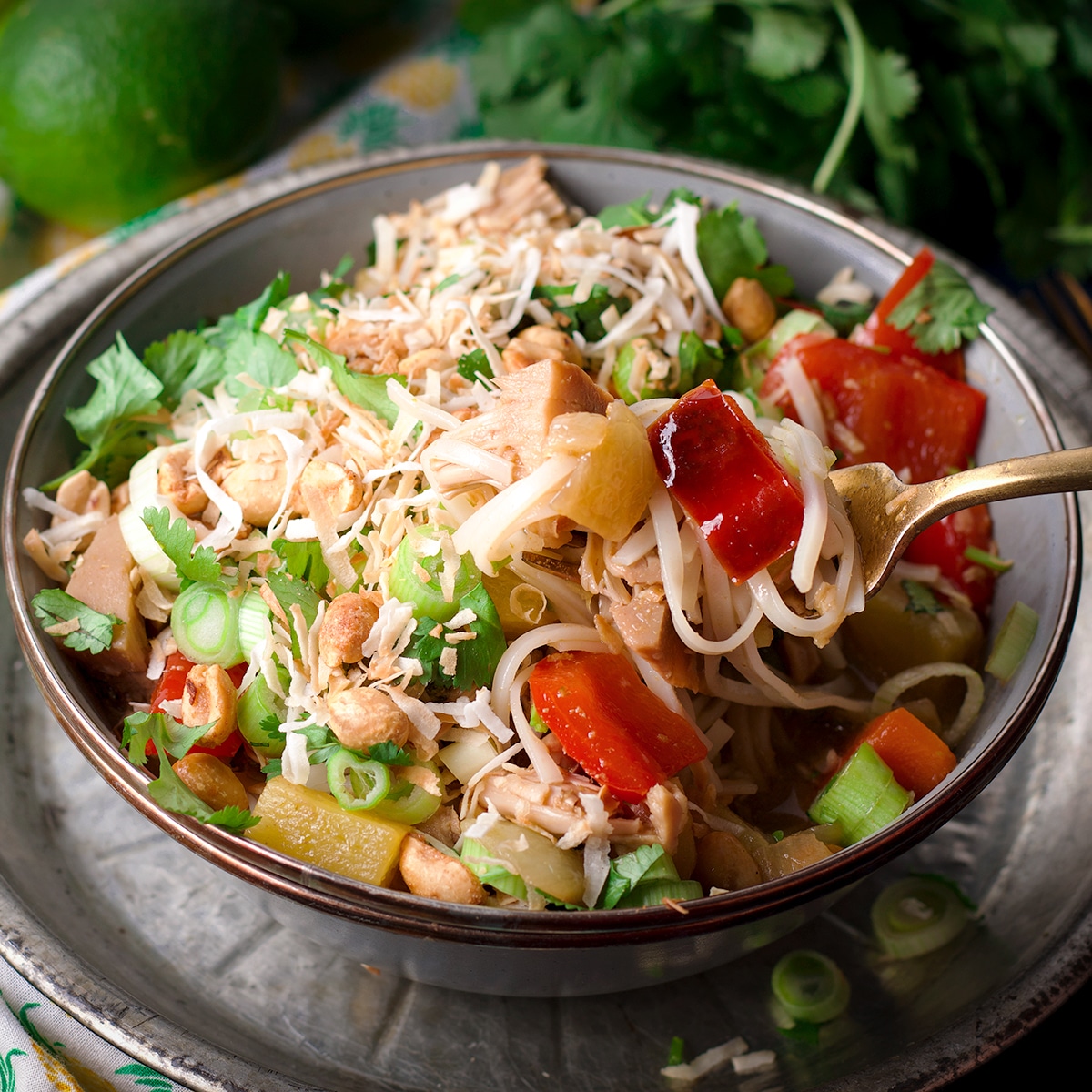
Related Recipes
Looking for other flavor-packed, plant-based recipes? If you love Pad Thai as much as I do, this Vegan Pad Thai recipe is better than take out. I've also recently discovered Pakistani style eggplant curry and am head-over-heels-in love.
A few other of my favorite go-to vegan recipes include:
What to Serve with Jackfruit Curry Bowls
Round out the meal with a side dish, cocktail, and dessert.
Finish off the meal with giant white chocolate chip raspberry cookies, thick slices of simple vanilla loaf cake, sweet and tart lemon bars.
Or, for special occasions, go all out with this orange olive oil cake with mascarpone frosting or a chocolate ricotta cake topped with fresh berry sauce.

+ Subscribe to my newsletter for new and exclusive recipes in your in-box every month! As a full time traveler, living, working, cooking, and baking from a 5th wheel RV, it's also where I share our experiences of life on the road.
If you give this recipe a try, let me know! Leave a comment, rate it, or take a picture and tag it #alittleandalot on Instagram.
📖 Recipe
Jackfruit Curry Bowls
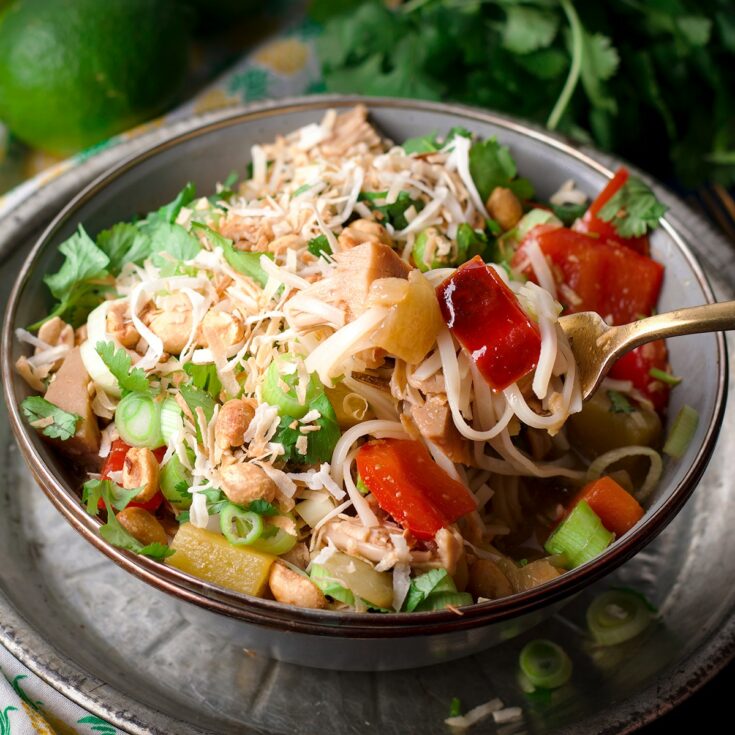
Warning! Big flavors are in your future with fresh veggies, jackfruit, and pineapple swimming in a luscious easy-to-make Thai-inspired green curry sauce.
Jackfruit curry bowls are a nutritious, plant-based way to satisfy your craving for big bowls of saucy, slurp-worthy noodles.
Ingredients
- 8 ounces Pad Thai rice noodles
- 4 tablespoons vegetable or canola oil, divided
- ⅓ cup chopped shallot (about 1 medium size shallot)
- 1 tablespoon fresh ginger, minced or grated
- 4 ounces of green curry paste - OR 2 tablespoons curry powder
- 20 ounces (2 ½ cups) of unsweetened coconut milk, from a carton or a can (avoid coconut milk labeled as "light")
- 1 cup vegetable broth, OR 1 tablespoon Better than Bouillon Vegetable base mixed with 1 cup water)
- 3 tablespoons granulated sugar
- ¼ teaspoon ground cayenne (optional)
- 1 tablespoon fish sauce, vegan fish sauce, or soy sauce/ Tamari
- 3 tablespoons soy sauce or Tamari
- 2 - 14 ounce cans of jackfruit, drained - OR cooked fresh jackfruit
- 1 yellow onion, peeled and chopped
- 1 cup (6 ounces, 150 grams) peeled and chopped carrots
- 1 heaping cup (90 grams, 3 ounces) of broccoli florets
- 2 red bell peppers (or any other color of bell pepper), seeds and stem removed and chopped
- Salt, to taste
- 1 ½ cups diced pineapple (fresh or from a can)
- 1-3 tablespoons fresh lime juice, to taste
- Toppings: roasted or raw cashews or peanuts, diced green onions, chopped fresh cilantro, and toasted sweetened or plain shredded coconut
Instructions
- Before you begin, chop the vegetables. Chop the shallot into small pieces and the rest of the vegetables into bite-size pieces. The size of the pieces doesn't really matter; what's important is that they are all relatively the same size so they cook at the same rate. (See photos above for reference.)
- Cook the noodles according to the package directions. Drain them in a colander in the sink and then immediately rinse with cold water to stop them from cooking. Set aside.
- Add 2 tablespoons of oil to a 2 or 3-quart saucepan. Add the chopped shallot and ginger and set the pan over medium heat. Cook, stirring occasionally, for 2-3 minutes, until the shallots are soft. Add the curry paste or curry powder and cook, stirring constantly, for 1 minute. Stir in the coconut milk, vegetable broth, sugar, cayenne (if using), fish sauce (if using), and soy sauce or Tamari.
- If the jackfruit is in large chunks, use your fingers or two forks to shred it. Add the Jackfruit to the curry sauce. Cover the pan and let the jackfruit simmer in the curry sauce for 20 minutes.
- While the jackfruit simmers in the curry sauce, add the remaining 2 tablespoons of oil to a 12-inch skillet and set it over high heat. When the oil is hot and shimmering, add the onions, carrots, broccoli, and bell peppers. Sprinkle with about ½ teaspoon salt. Sauté until the veggies are starting to brown in spots. Stir in pineapple.
- Pour the curry sauce and shredded jackfruit into the skillet with the veggies and pineapple. Add 1 tablespoon lime juice. Bring everything to a simmer. Taste and add more lime juice and salt if you like.
- To Serve: Pile noodles into bowls and ladle the hot jackfruit curry over them. The curry will reheat the noodles. Serve with all or some of the suggested toppings.
Notes
- The curry sauce in this recipe is very thin. If you want your sauce to be thick enough to coat the noodles, add 1 tablespoon of cornstarch to a small bowl and stir in about ½ cup of the hot curry sauce. Stir the cornstarch slurry back into the rest of the sauce and heat and stir to thicken. Repeat with more cornstarch until you achieve the desired consistency.
- If you want to keep these curry bowls 100% vegan, be sure to use vegan fish sauce or just omit it altogether and add a bit more soy sauce instead.
- If you, or someone you are cooking for, is on a gluten-free diet be sure to use Tamari instead of soy sauce and make sure the package of rice noodles says they are gluten-free.
- Jackfruit curry bowls are endlessly customizable to whatever you want or whatever you have. Use different veggies, mango or oranges instead of pineapple, different noodles, or red curry instead of green. Scroll up to the "Substitutions and Additions" section for a list of ways to change up these curry bowls.
Recommended Products
As an Amazon Associate and member of other affiliate programs, I earn from qualifying purchases.
-
San-J Tamari, Gluten Free Soy Sauce, Vegan, Non-GMO
-
Native Forest Organic Jackfruit, 14 Ounce (Pack of 6)
-
No Fish Sauce by Ocean's Halo
-
Thai Kitchen Gluten Free Green Curry Paste, 4 Ounce (Pack of 6)
-
Better Than Bouillon Premium Seasoned Vegetable Base
-
Annie Chun's Pad Thai Rice Noodles, Non GMO, Vegan, Gluten Free
-
Thai Kitchen Unsweetened Coconut Milk, 25.36 Fl Oz
Nutrition Information:
Yield:
4Serving Size:
1Amount Per Serving: Calories: 559Total Fat: 18gSaturated Fat: 4gTrans Fat: 0gUnsaturated Fat: 12gCholesterol: 0mgSodium: 2717mgCarbohydrates: 101gFiber: 8gSugar: 23gProtein: 7g



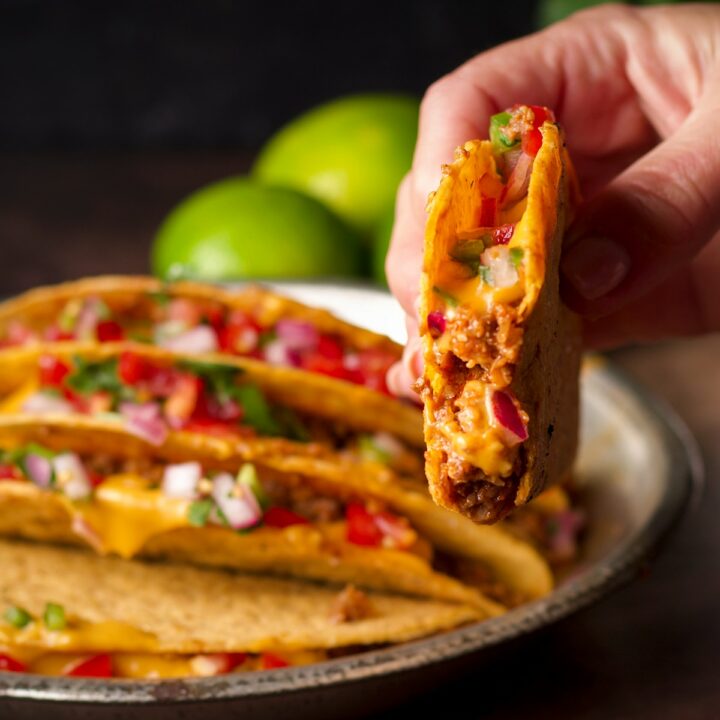
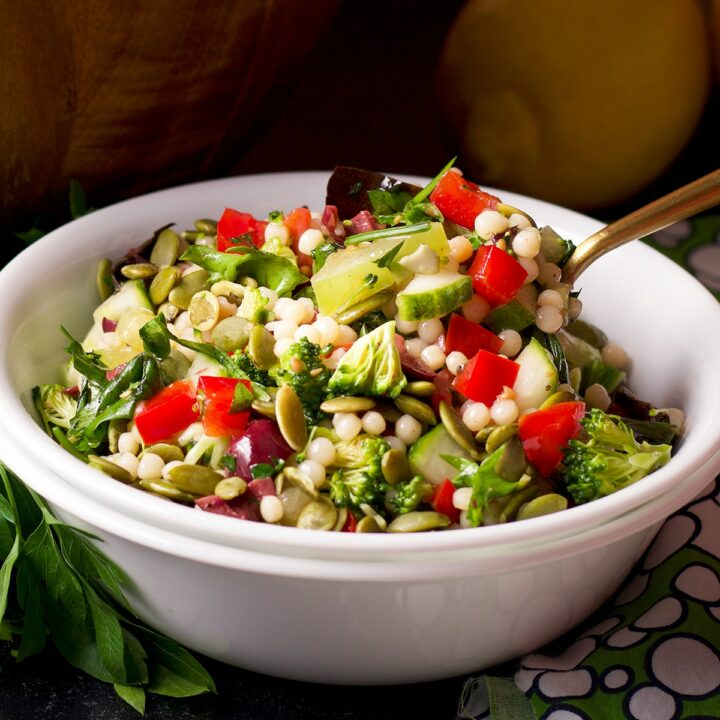
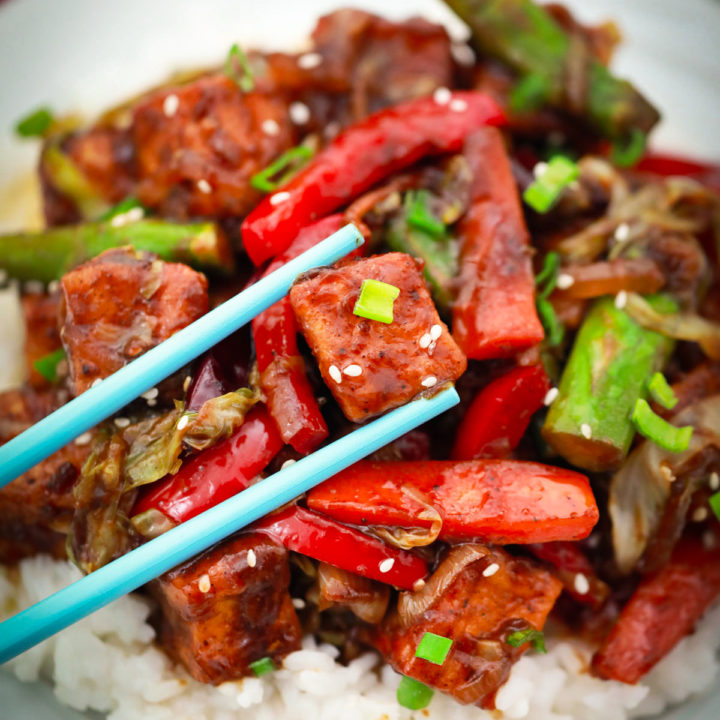
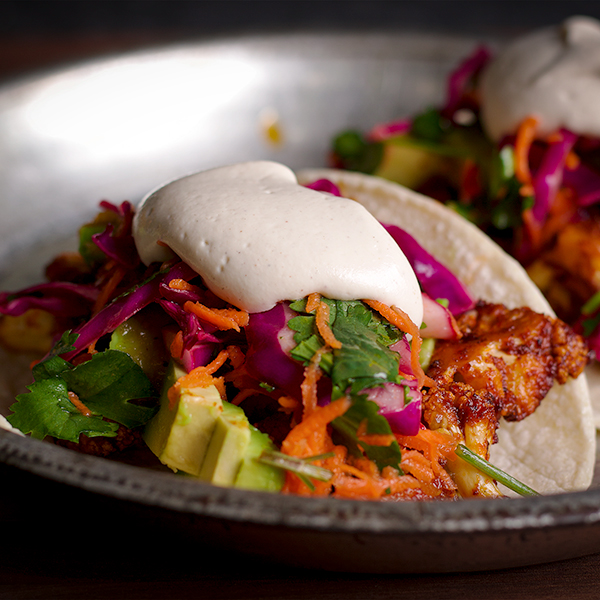
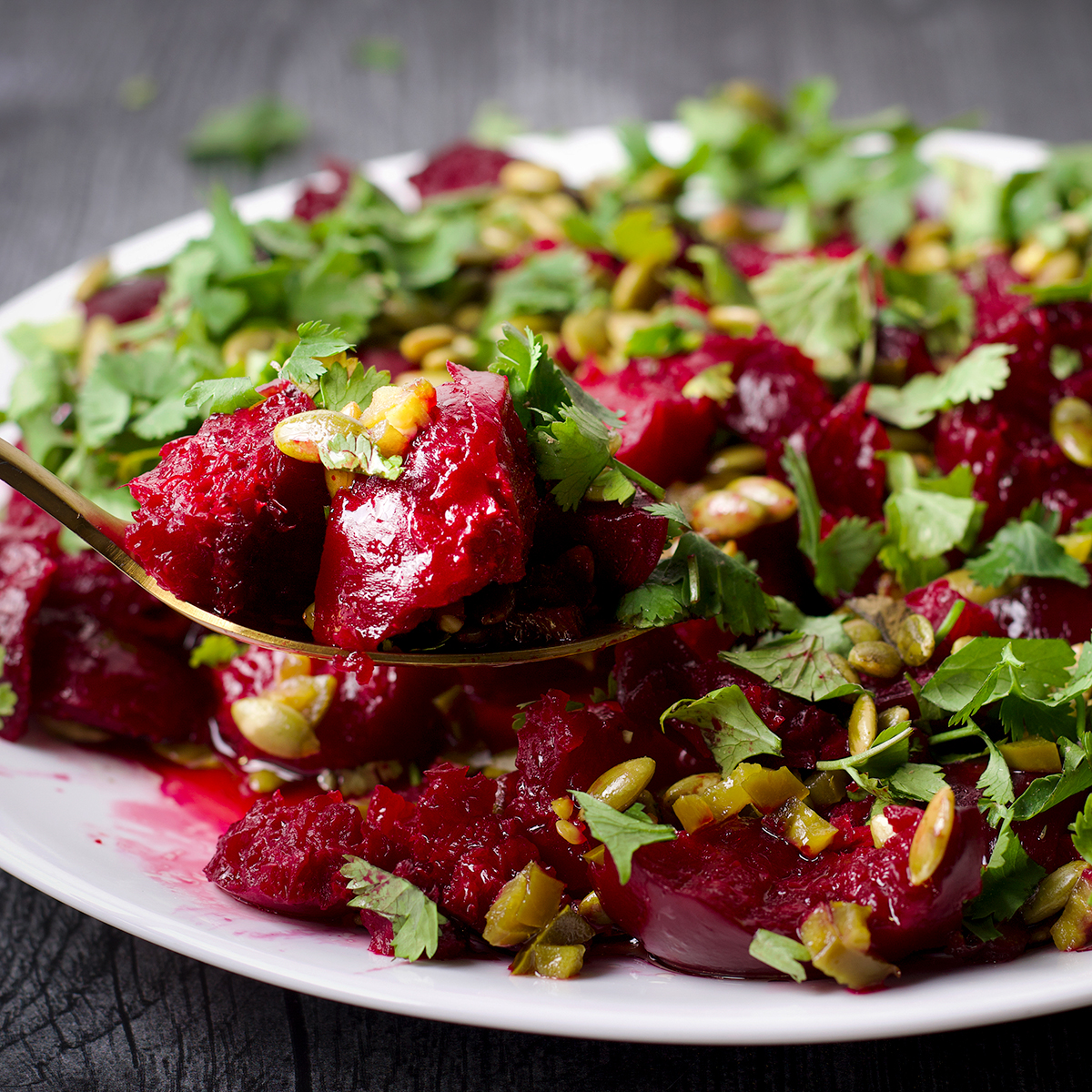
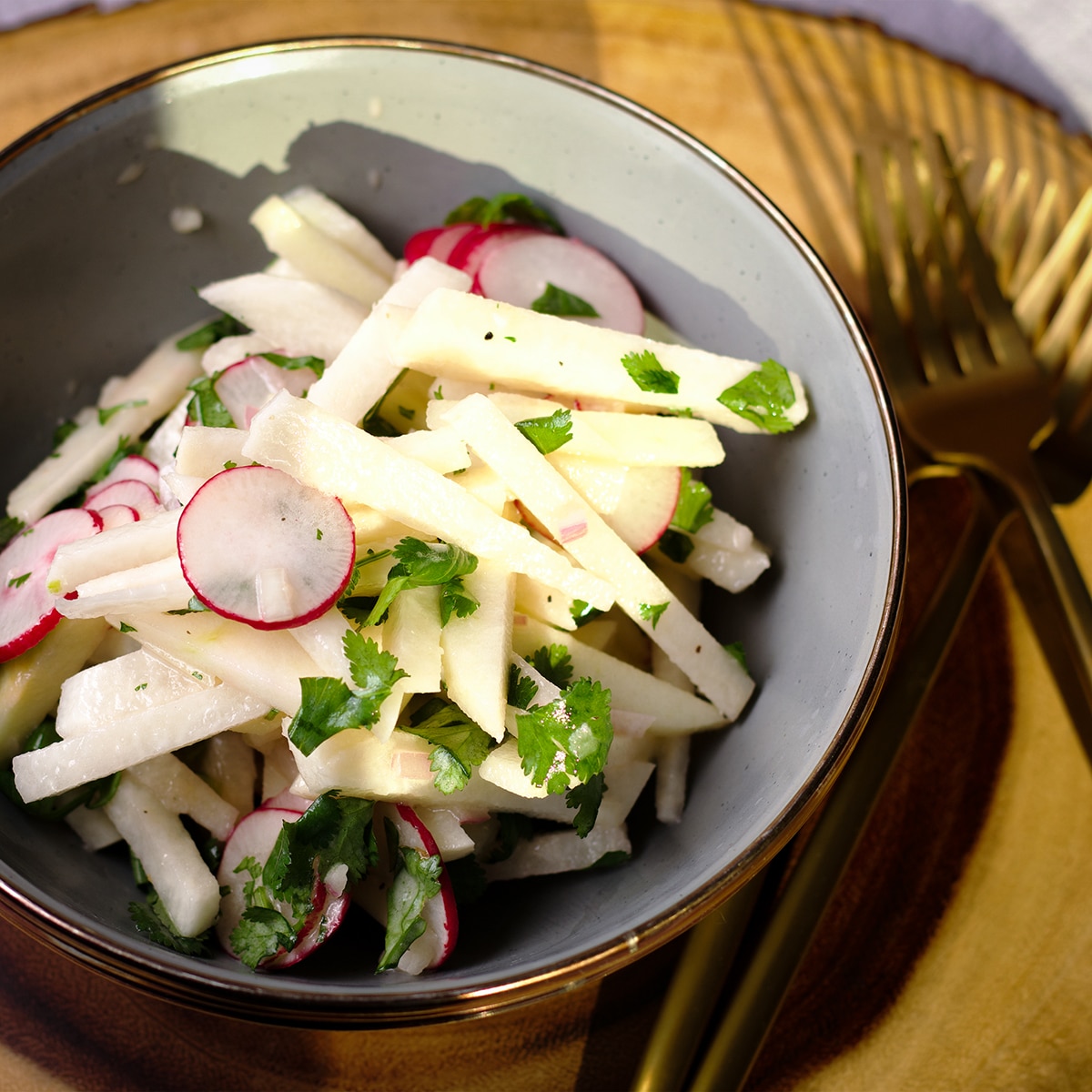









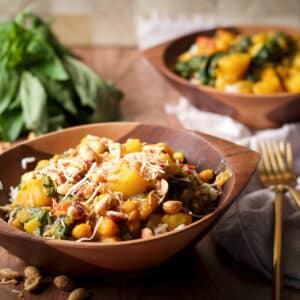
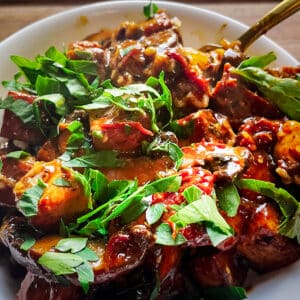
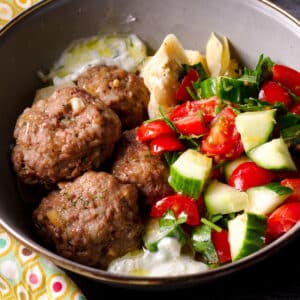
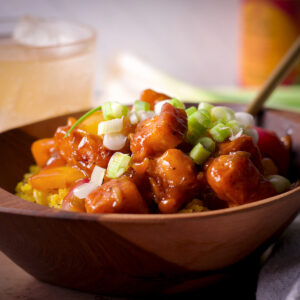
Comments
No Comments